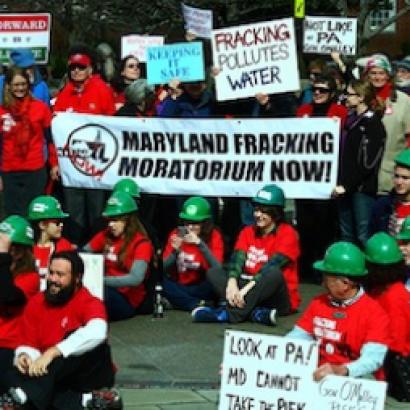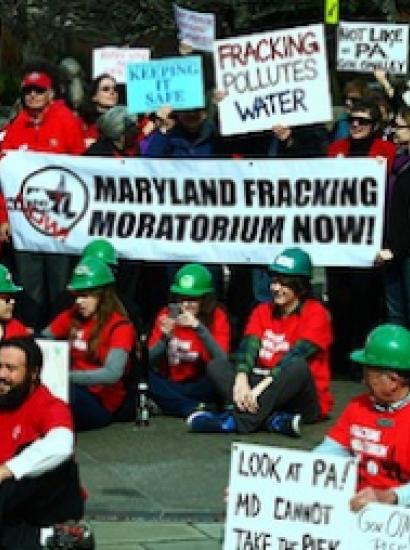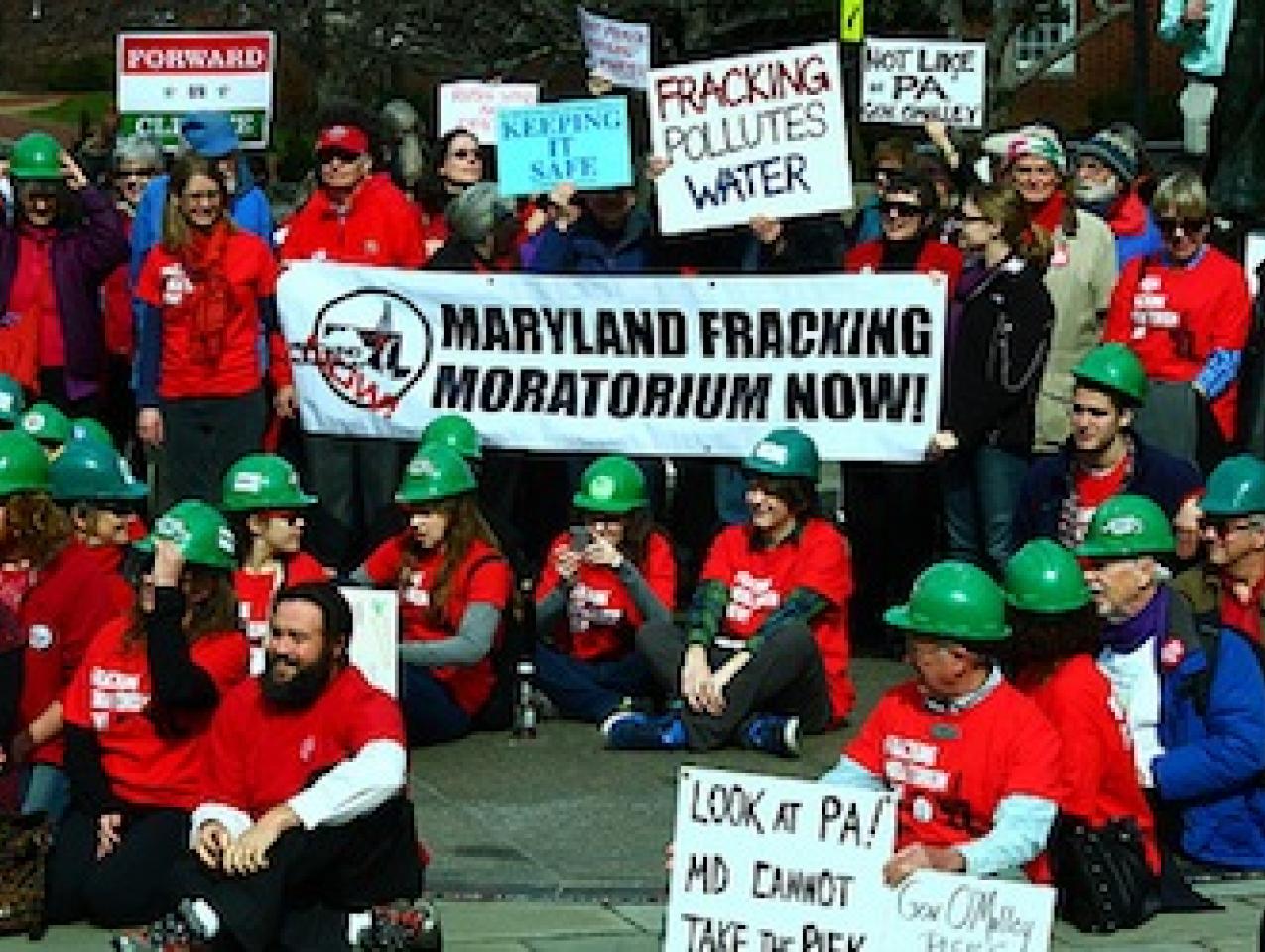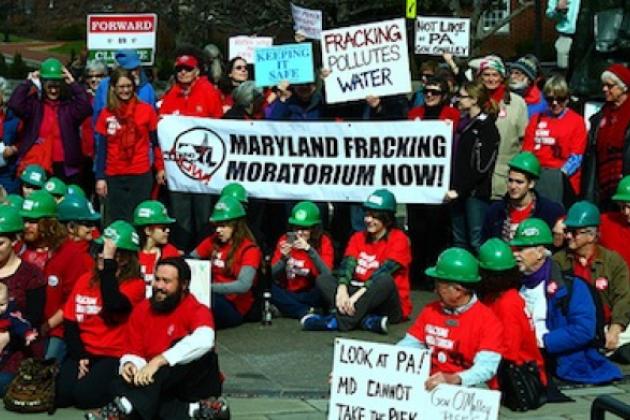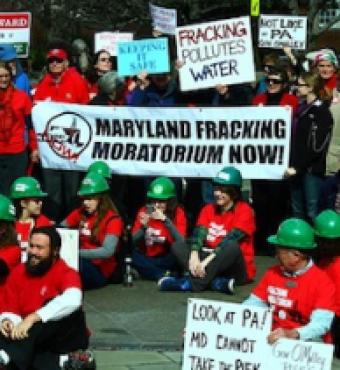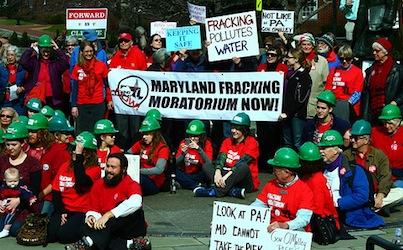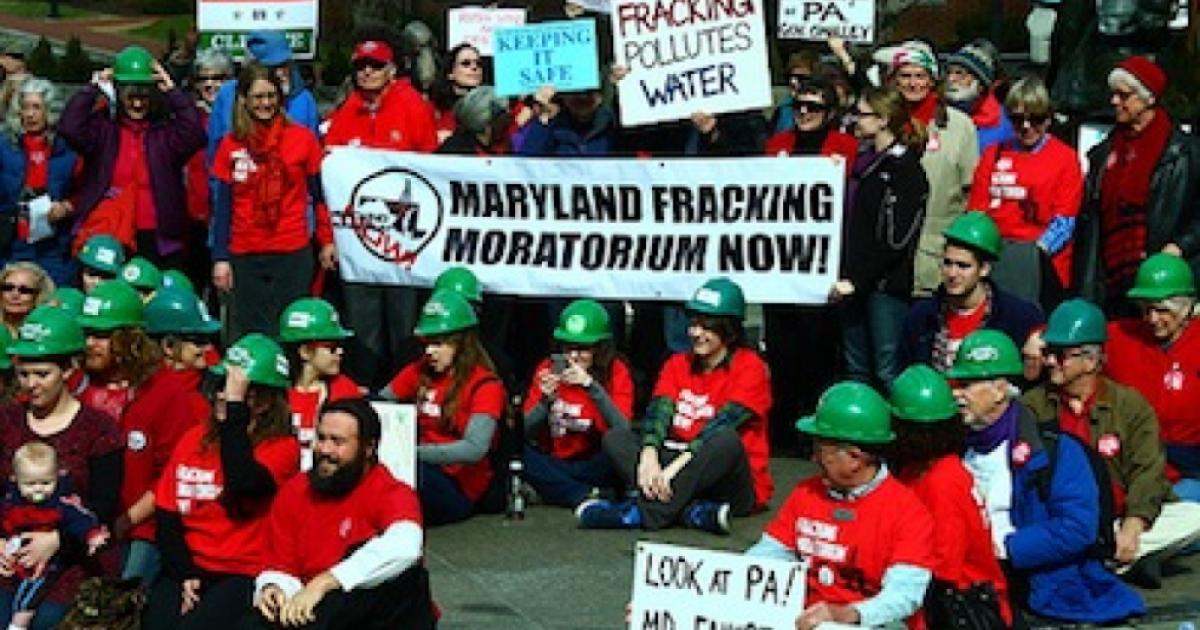- Economics
- Energy & Environment
Americans should celebrate fracking. By unleashing production of unconventional hydrocarbons, fracking has catapulted the U.S. from being a has-been producer of oil to the world’s largest total supplier in 2013 when we include natural gas liquids, biofuels, and crude oil. The U.S. produced around an average of 12.1 million barrels a day of these liquids, 300,000 barrels a day more than Saudi Arabia and 1.6 million more than Russia, the previous leaders.
This increase in U.S. output has not been matched since 1940 when the country was blessed with flush new primary production from oil fields in Texas, New Mexico, Louisiana, and Oklahoma. Shale-gas production from the Bakken Formation in North Dakota, the Eagle Ford Formation in Texas, and the Marcellus Formation that crosses parts of West Virginia, Ohio, Pennsylvania, and New York now accounts for 44% of total U.S. natural gas output, and eventually could account for nearly 70%.
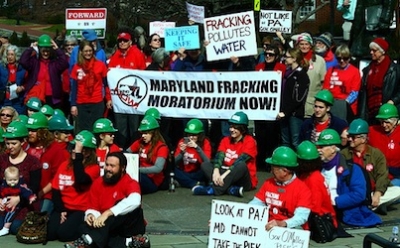
Photo credit: Maryland Sierra Club
The hydrocarbon boom in the U.S. is driven by fracking. Hydraulic fracking is a technique whereby water mixed typically with sand and chemicals is injected with high pressure into non-permeable hydrocarbon-bearing geologic formations to create small fractures that are held open with small grains of sand. These fissures allow otherwise-locked hydrocarbons to flow to the well. Horizontal drilling is used to access oil and gas deposits away from the main vertical well.
This combination of fracking and horizontal drilling accounts for vast new production of shale (tight) gas, shale (tight) oil, and coal-seam gas. It has been a game changer by releasing hydrocarbons from rock formations 5,000 to 20,000 below the earth’s surface where there is little permeability or reservoir pressure to allow hydrocarbons to flow to conventional wells. Absent fracking, these oil and gas deposits would not be economic, but with it, they have become sources of a new bonanza for the country and the world.
In the 1970s, there were predictions that the U.S. would run out of natural gas, and indeed, federal price controls were implemented in an attempt to shield consumers from higher gas prices. These policies, of course, did little to promote new exploration and discovery. Beginning in 1978, price controls were phased out, but there were still concerns about the future supply of natural gas. Moreover, U.S. oil production was declining, especially after output from the Prudhoe Bay field in Alaska tapered off.
Between the early 1990s and 2008, U.S. oil output fell gradually, fueling notions of “Peak Oil” and related doomsday predictions that natural resources were finite in supply and that the country would soon pay the price of consuming “unsustainably.” World oil prices rose; U.S. imports increased especially from politically-unstable countries, often led by unfriendly leaders in the Middle East, Africa, and South America; and there was a corresponding preoccupation among American political leaders in “energy independence.” The sharp economic downturn that began in 2007 was intensified by high energy prices and large trade imbalances. At the same time, the environmental community lobbied for subsidies for renewable fuels to move the U.S. away from dependence on fossil fuels and foreign sources of supply and to reduce greenhouse gas (GHG) emissions.
Fracking has upended all of this. It has provided the U.S. with energy independence, an elusive goal thus far with renewables; lowered overall energy prices and modulated natural gas price swings, even in the face of one-of the severest winters in recent memory; raised U.S. natural gas exports (oil exports are banned by federal law); drove U.S. imports of liquid natural gas (LNG) to zero, saving $100 billion annual in imports; tempered any rise in worldwide oil and gas prices to the benefit of most of the world’s populations and economies; shown the way for new natural gas and oil production in Europe, lessoning dependence on Russian sources and its monopoly Gazprom; lowered U.S. demand for Venezuelan oil upon which the country’s increasingly-autocratic rulers depend; directly boosted U.S. employment in oil and gas extraction by 28,000 jobs between 2007 and 2011 alone and indirectly by 45,000 in new employment in support industries; and stimulated broader job growth and GDP expansion.
In the fourth quarter 2013, GDP grew at a 3.2% annual rate, which would have been 1.3 percentage points lower were it not for an inflation-adjusted narrowing of the trade deficit by nearly 12%, driven by the fall in oil imports and increased exports. Manufacturing has expanded in the U.S. in light of lower and more certain energy costs relative to other countries and cheaper natural gas feed stocks in chemicals. Lower energy costs alone could raise annual GDP growth by between .09 and .19 percentage points through 2020. Between 2008 and 2035 shale gas and oil production could add an average of $475 billion a year to the American economy, about 3% of current GDP. In an otherwise anemic economy, fracking is truly a major bright spot.
Finally, the shift to low-cost natural gas from coal in energy generation has contributed to the decline in U.S. GHG emissions. Natural gas-fired power plants emit about half as much CO2 as comparable coal-fired ones. As a result, the U.S. is lowering GHG emissions more rapidly and at lower cost than the European Union which has relied far more on subsidizing costly renewable sources—solar and wind power, while as described below, blocking or discouraging use of fracking even in the face of very favorable geologic formations in some countries, such as France, Germany, and Bulgaria. Indeed, in Germany overall coal demand for energy production has grown over the past decade.
The Importance of Private Property Rights
New fracking and horizontal drilling technologies are dominantly developed and implemented in the U.S. Why is that? The answer is secure private property rights to subsurface minerals. These are the major reason why the American oil and natural gas industry has been so dynamic and innovative. Except for western Canada, throughout the world, subsurface mineral rights are held by governments, and indeed, the U.S. government also holds the rights to hydrocarbon deposits on federal lands. The incentives for and transaction costs of investing in and using new fracking, pumping, and drilling technologies are dramatically different between private and public ownership.
When private parties own the mineral rights (often surface land owners), they capture any expected benefits from new discoveries and associated production. In North Dakota, land owners above the Bakken Formation are part of a new generation of oil millionaires in a relatively remote and semi-arid region that previously had seen population declines and economic stagnation. These owners also bear many of the costs, including any environmental ones, such as potential ground water contamination or depletion, because these costs generally are localized in the vicinity of fracking wells. Where they are not, rights holders or the companies they contract with may be held accountable for damages inflicted on others.
Bonding requirements to cover environmental damages also can be used both for mitigation and for indentifying the opportunity costs to rights holders and drilling companies of any harm they inflict on others. Bonding requirements and potential litigation instill incentives for careful production practices. With this information, current mineral rights owners can weigh the benefits and costs of exploration, drilling, and production, and decide whether or not to contract with hydrocarbon-producing firms. If others are more optimistic than are current owners, they can purchase lands and/or mineral rights and engage in exploration and production contracts with oil and gas firms. The transaction costs of these decisions are low.
Stable property rights to mineral lands also provide motivation for hydrocarbon-producing firms to engage in long-term risky investments in new production technologies, such as fracking and horizontal drilling. When mineral rights are not secure or are held by the state and hence less predictable for reasons described below, entrepreneurs have reduced incentives to explore durable, long-range, but risky technologies. This is the major reason why fracking and horizontal drilling have been pioneered in the U.S. and not in other countries.
In contrast, consider the far-more-common case where the state owns the mineral rights. Under these conditions, there are fewer benefits for entrepreneurial investigation into new technologies and potentially, far more costs. Surface land owners do not directly benefit. They may only see costs and hence, have little motive to support new exploratory drilling. Even if surface landowners receive a payment from the state, these payments are unlikely to be closely tied to the benefits and costs of production on or near a particular property as they are with private property rights. Instead, the payments are likely to be on a per-capita basis or provided as a lump sum to local governments, where the distribution will be subject to political pressures and uncertain.
Because the incentives of landowners and other constituents are mixed at best, exploration and production firms are more apt to face local opposition, which in turn could lead to new regulation or abrogation of the rights to explore and develop. This setting creates long-term uncertainty for entrepreneurs.
Moreover, and perhaps most important, the transaction costs of exploration and production of hydrocarbons are much greater when the state owns the mineral rights. No politician or agency official is a direct residual claimant to the added net value of exploring, finding, and producing new natural gas and oil. They are, however, residual claimants to the actions of interest groups. In the political arena there are many different parties with varying views of fracking and greater fossil fuel production. Accordingly, long-term commitments for production leases and royalty payments are difficult to secure. Regulations can be adjusted whenever a sufficient number of politically-influential interest groups mobilize. This political risk lowers the returns to entrepreneurship in technology development, exploration, and production.
The evidence is clear on these points. Fracking and horizontal drilling are old concepts that have been refined and applied, primarily on private lands in the U.S. and western Canada. Hydraulic fracking was used experimentally in the late 1940s in the U.S. by George Mitchell of Mitchell Energy and Development. Mitchell Energy successfully applied the technologies on a large scale to the Barnett Shale of Texas in the 1990s and more recently many other entrepreneurial firms have used shale fracking and other improved drilling techniques in other areas. Although there were Department of Energy research grants and subsidies in the 1970s to spur production of natural gas, these alone would not have resulted in the widespread adoption of fracking and horizontal-drilling technologies. Implementation required secure property rights.
These techniques are now being considered elsewhere, but where governments own the mineral rights. In these settings, groups that do not directly benefit from fracking or bear few costs from opposing it, can mobilize to slow or block use of the technology. France and Bulgaria, countries with large shale-gas reserves have banned the practice following intense lobbying from a variety of sectors. Farmers in Australia oppose fracking that they see only as leading to messy new wells with little in return for them. In Germany fracking has been banned de facto at the urging of many green groups among others. Germany is phasing out nuclear energy, has subsidized costly renewables, but nevertheless relies increasingly on coal and has among Europe’s highest energy prices. Fracking and new production from the country’s promising hydrocarbon formations could certainty benefit consumers and producers, but well-organized opposition means this opportunity is not likely to materialize.
In the U.S. about 25-30% of fracked wells are on federal, mostly BLM, land. Because of potential environmental damages each state regulates fracking, but the BLM is proposing new federal oversights that could displace state regulations with far tighter controls. Federal lands and regulation are more subject to broad political interest group demands than are state regulations, weakening any contractual rights gained through federal mineral leases. Political constituencies within states capture more of the benefits (and bear more of the costs) of fracking than do external groups and hence lobby for policies that reflect those benefits and costs. In the broader federal political arena, however, other interests with little at stake can lobby federal agencies such as the BLM for policies they desire. In particular many environmental groups strongly oppose fracking because it promotes fossil fuel production and use, when they have long sought to replace fossil fuels with solar, wind, and biofuels.
Why Are Mineral Rights Private in the U.S.?
Until the late nineteenth century, mineral rights were viewed as any other right to productive natural resources in America—they were to be private. When European settlement moved across the North American continent beginning in the late seventeenth century, there was never the sense that the government would own the land. Indeed, access to land was a major impetus for migrants to come to North America. Much of American history is one of movement of the frontier across the continent as individuals claimed land, created farms, and speculated in land holdings. Federal land laws were designed to facilitate the rapid transfer of title to land from the federal government to private claimants. Land ownership and market exchange was the primary means by which wealth was acquired through the nineteenth century. The Jeffersonian notion of a nation of small farmers as the basis for social and economic stability and progress was not a myth.
Until 1848, minerals were of little consequence. There were few significant ore discoveries so that the focus of land laws was on providing private title to agricultural land. The California Gold Rush and subsequent hard-rock mineral discoveries in the Far West, however, changed all of this. Mineral rights became of value. Although there was English precedent for reserving subsurface rights by the government, the 49ers had something quite different in mind. They wanted secure private mineral rights to support their search and discovery of potentially-fabulously-rich ore deposits. The federal government was far removed across the continent and could do little to stop private claiming of western mineral lands.
Throughout the West, over 600 local mining camp rules were created by prospectors to assign private mineral rights. Mining became a dominant industry in most states, and the wealthiest citizens were successful miners and investors. Local mining property rules were incorporated into territorial and state laws, and eventually into the federal Mining Law of 1872 that still allows private individuals to establish mineral rights for hard-rock minerals on federal lands. With this precedent, private mineral rights remained with surface land owners. Only with the establishment of the National Forests, National Parks, federal grazing lands, (BLM) lands, and Naval Oil Reserves in the late nineteenth and early to mid twentieth centuries were mineral rights to coal and hydrocarbons retained by the federal government on federal lands.
In the case of hard-rock mining, secure mineral rights led to the rapid development of the U.S. mining industry. Moreover, American mining and engineering schools and technologies became world leaders. With this institutional framework in place, the U.S. economy became more mineral intensive in production than the country’s physical resource endowments alone would have dictated.
In the case of oil and natural gas, early expansion was in Pennsylvania, Texas, Oklahoma, Illinois, Kansas, and parts of California, primarily all on private lands where private mineral rights were in place. Major world-class schools of petroleum engineering were established to study new techniques and to train petroleum engineers for exploration and development, much as innovative software techniques are researched in other engineering schools. Oil and gas law became the focus of many law schools to lower the costs of writing contracts between landowners and exploration and production firms and between producers and oil and gas supply firms.
Today, much of the new development of fracking and horizontal drilling occurs on private lands. Federal lands could play an increasingly important role given their location near existing productive formations. Whether this happens depends upon the enactment of supportive federal policies. But there are many who oppose such actions. If these groups are successful, federal lands will not produce to their potential in support of fracking and natural gas production that has been good for the economy, good for democracies worldwide, and good for the environment.








